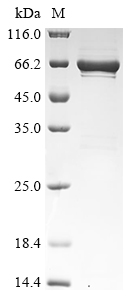This recombinant human serine/threonine-protein phosphatase 5 (PPP5C) is expressed in E. coli. The production process begins by introducing a gene fragment encoding the full-length mature human PPP5C protein (amino acids 2-499) into a suitable expression vector. The vector is designed to incorporate an N-terminal 10xHis-tag and a C-terminal Myc-tag for easy detection and purification of the recombinant protein. The recombinant construct is then transformed into E. coli cells, followed by the selection of transformed cells to ensure the presence of the recombinant plasmid. Subsequently, a large-scale culture is established, providing optimal conditions for protein expression. The expressed recombinant PPP5C protein is harvested from the cells and purified to achieve a high level of purity. SDS-PAGE analysis confirms the purity of the protein, which reaches up to 85%. When visualized on the gel, the recombinant Gpi protein migrates as a distinct band with an approximate molecular weight of 66 kDa.






